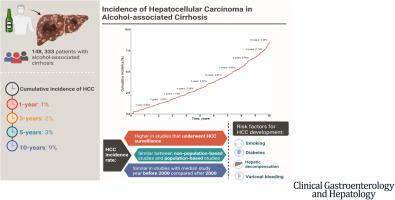Clinical Gastroenterology and Hepatology ( IF 11.6 ) Pub Date : 2022-08-05 , DOI: 10.1016/j.cgh.2022.06.032 Daniel Q Huang 1 , Darren J H Tan 2 , Cheng Han Ng 2 , Maral Amangurbanova 3 , Nancy Sutter 3 , Phoebe Wen Lin Tay 2 , Wen Hui Lim 2 , Jie Ning Yong 2 , Ansel Tang 2 , Nicholas Syn 2 , Mark D Muthiah 4 , Eunice X X Tan 4 , Shravan Dave 3 , Benjamin Tay 5 , Abdul M Majzoub 6 , Danielle Gerberi 7 , Beom Kyung Kim 8 , Rohit Loomba 3

|
Background & Aims
Alcohol is one of the leading causes of hepatocellular carcinoma (HCC). However, pooled estimates of HCC incidence in alcohol-associated cirrhosis have not been evaluated systematically. We performed a pooled analysis of time-to-event data to provide robust estimates for the incidence of HCC in alcohol-associated cirrhosis.
MethodS
Medline, Embase, Cochrane Central Register, Scopus, and Web of Science were searched from inception to August 2021. Individual patient data were reconstructed from published Kaplan–Meier curves, and a pooled analysis of cumulative HCC incidence was performed using a random-effects model.
Results
We screened 5022 articles and included 18 studies (148,333 patients). In the pooled analysis, the cumulative incidence of HCC in alcohol-associated cirrhosis at 1, 5, and 10 years among studies that accounted for the competing risk of death without HCC was 1%, 3%, and 9%, respectively. A secondary analysis by traditional meta-analysis determined that the HCC incidence rate was higher in cohorts enrolled in a HCC surveillance program (18.6 vs 4.8 per 1000 person-years; P = .001) vs those who were not enrolled in a surveillance program. Meta-regression showed that diabetes, smoking, variceal bleeding, and hepatic decompensation were associated with a higher risk of HCC.
ConclusionS
Our analysis determined that the 5- and 10- year cumulative risk of HCC in alcohol-associated cirrhosis was 3% and 9%, respectively, with a higher incidence in cohorts that were enrolled in a HCC surveillance program. These data should be validated further in large prospective studies, and may have important implications for HCC screening and surveillance among patients with alcohol-associated cirrhosis.
中文翻译:

酒精相关性肝硬化中的肝细胞癌发病率:系统评价和荟萃分析
背景与目标
酒精是导致肝细胞癌 (HCC) 的主要原因之一。然而,酒精相关性肝硬化中 HCC 发病率的汇总估计尚未得到系统评估。我们对事件发生时间数据进行了汇总分析,为酒精相关性肝硬化中 HCC 的发病率提供可靠的估计。
方法
从开始到 2021 年 8 月,对 Medline、Embase、Cochrane Central Register、Scopus 和 Web of Science 进行了检索。根据已发表的 Kaplan-Meier 曲线重建了个体患者数据,并使用随机效应模型对累积 HCC 发病率进行了汇总分析。
结果
我们筛选了 5022 篇文章,纳入 18 项研究(148,333 名患者)。在汇总分析中,在考虑非 HCC 死亡竞争风险的研究中,酒精相关性肝硬化中 HCC 的累积发病率在 1 年、5 年和 10 年分别为 1%、3% 和 9%。传统荟萃分析的二次分析确定,与未参加监测计划的人群相比,参加 HCC 监测计划的队列的 HCC 发病率较高(每 1000 人年 18.6 例 vs 4.8 例; P = .001)。荟萃回归显示,糖尿病、吸烟、静脉曲张出血和肝功能失代偿与 HCC 风险较高相关。
结论S
我们的分析确定,酒精相关性肝硬化中 HCC 的 5 年和 10 年累积风险分别为 3% 和 9%,在参加 HCC 监测计划的队列中发病率较高。这些数据应在大型前瞻性研究中得到进一步验证,并且可能对酒精相关性肝硬化患者的 HCC 筛查和监测具有重要意义。









































 京公网安备 11010802027423号
京公网安备 11010802027423号